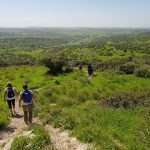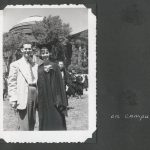Once upon a time, in the 1980s and 1990s, we did not have digital cameras or smartphones or Skype. We used VHS tapes to visually record and share our experiences.
In late 1985, when our oldest child was just a few months old and our home in Israel was under construction, we acquired our first VHS camcorder. It was bulky and heavy, and required the support of one’s shoulder or a tripod. Subsequently we owned smaller and lighter VHS-C camcorders, with improved video quality, but image resolution was still far behind that of today’s technology.
Over the next two decades, we amassed nearly 200 videotapes of family memories, mostly of our own creation, but also a fair number recorded by others, and including videotapes retrieved from my parents’ house. The collection fills up two large plastic storage bins.
A few months ago I had 140 videotapes converted to digital files by a local expert (MediaCreative). The physical volume of several hundred hours of video recordings has now been reduced to an external disk drive that I can hold in one hand.

Preparing the tapes for digitization was time consuming, but not too difficult. I was fortunate in a few respects.
First, our own tapes are marked in numerical order and labeled with dates. I also have an index of these tapes on a computer file. Moreover, attached to each box of the older VHS tapes is a detailed list of contents, meticulously noted by my mother as she watched the tapes and prepared to share them with other family members. I scanned each note to a page, and combined all the pages into one PDF file for reference and preservation.
Second, our videotape player still works (!) and easily connects to a TV screen. But three old adapters for VHS-compact tapes all failed to deploy. So I ordered one from Amazon USA, and then ordered another from Amazon UK, just to be on the safe side; who knows how much longer these devices will be available. Reminder: to prevent corrosion and device failure, remove battery from adapter when not in use.
Once the equipment was set up, I had a number of viewing sessions. First I looked at tapes from other sources and unlabeled tapes, and decided whether or not to digitize. Then I compared duplicate tapes to identify the better original one, and discard the copy. Last, I organized the tapes into a few categories, numbered and labeled where needed, and updated my index file.
It was easy to get hooked for hours watching home videos I had not seen for many years. I did my best to watch only as much as was necessary, knowing I would have many more hours of viewing during the editing process.
Over the past few months I extracted segments from the videotapes, edited, captioned, and generated video clips. I have been using a thematic method, and have so far uploaded about 100 clips into several albums (playlists) on my YouTube channel.
My first archive of movie clips, which required little work, is a collection of jeep trips. In the years of videotaping our family did a lot of off-roading with friends from Maccabim, and a number of those trips were recorded for posterity. (Not yet on YouTube.)
The second collection (Archive – Maccabim מכבים ישוב קהילתי) required more serious editing, and is devoted to the early years of community life in the town of Maccabim. Most footage was taken during celebrations and ceremonies, in the nursery school, kindergarten and elementary school. I edited these clips to show as many of our neighbors and children’s classmates as possible. I have shared these clips through local social media, and the reactions have been extremely positive and appreciative, especially from neighbors whose kids happen to be sitting/standing/dancing next to one of my kids in a movie clip.
The third collection (Archive – Meyer-Saltzman 8mm) was a special treat for me since I was not familiar with the films. I created the archive from three videotapes containing converted 8mm movies taken in the late 1940s and 1950s. My grandmother Ruth Radman Meyer was an avid photographer and I believe she is responsible for most of these films. Two videotapes contained conversions my parents had done, while the third came from my great-uncle Jerome Meyer’s family.
The films on the first two tapes had not been converted in chronological order, but each segment had a reel or a box number. This which allowed me to splice the digital version, and then rearrange the segments. Since my brothers and I figure prominently as infants and toddlers in these clips, it was easy to estimate the dates. From the third tape, which contained the oldest family films, I extracted, edited and added captions to identify the individuals of most interest to my immediate family and first cousins. I expect that second, third and generation-removed cousins will also appreciate seeing moving images of our ancestors. Just imagine – my infant grandson Omri will one day be able to see movie clips of his great–great–great grandparents, Annie Meyer and Lena and Sam Radman.
As time allows, I continue to cull and compile videos, and share them with friends and family.
Occasionally, I come across a silly or sweet video moment from the kids’ childhood. I make a quick clip and send it to our family’s whatsapp group, and we share a virtual group laugh.
My nostalgia. My family-tree “Roots”project. My posterity.

